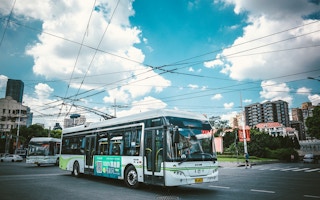Air quality is a growing concern for many Asian cities as poor air quality has direct health impacts for residents. Transport contributes to this deteriorating air quality via greenhouse gas (GHG) and particulate matter emanating from exhaust pipes of vehicles.
One way to stem air pollution from transport is to deploy low-carbon emission buses (LCBs), which include hybrid, plug-in hybrid, and battery electric buses (BEB).
The People’s Republic of China (PRC) has one of the world’s largest fleets of electric and plug-in hybrid buses, with around 300,000 plying its urban streets. The PRC’s experience in putting low-carbon buses on the road can provide lessons for other cities as they make decisions about how to use this technology.
We assessed how things were working in 16 cities across the PRC. This is what we learned.
“
As the PRC moves forward on electric urban buses, its technology and policies is likely that battery electric buses will become more popular due to their environment and financial benefits.
Technology
Hybrid buses have one of two sources of onboard power (diesel-hybrid or gas-hybrid) with a small battery. They are used as an intermediate technology toward full electrification, especially for larger buses and long routes with high passenger demand.
In PRC cities, hybrids use around 20 per cent less fuel than fossil fuel buses, with an incremental 20 per cent higher investment cost that is recovered from energy savings during the lifetime of the vehicle.
Plug-in hybrid buses, which can be directly charged at the grid, are very popular in the PRC. Although they cost 20 per cent more than standard hybrids, most drivers do not always charge their buses, so the environmental impact is similar.
Purchasing plug-in hybrids is therefore not advisable due to their higher cost and limited additional environmental value compared to standard hybrids.
BEBs are fully electric buses that have different charging configurations. They include vehicles charged only overnight, those that are fast-charged during the day, “opportunity charge” BEBs charged at the end of routes or at stops, and electric trolleybuses that operate with overhead wiring.
The chosen system configuration determines the quantity of batteries (and therefore the price), the charging infrastructure, the electricity price (which is dependent on when the bus charged and which power is used to charge the bus), and the operational management of the buses.
BEBs are best used on short- to medium-distance routes with buses up to 12m long, while opportunity charge systems and trolleybuses are ideal for high-demand and long routes with articulated vehicles.
Bus operators need to optimise the electric bus system configuration and charging scheme. They must consider parameters such as route distance, performance in the summer with air conditioning use, battery reserve rates, and battery capacity that declines over time.
The optimal configuration will also depend on technical and route criteria and electricity prices.
Picking the most effective and cost-efficient electric bus is a far more complex procedure than choosing between diesel and gas, and most PRC cities have not carried out this process in a stringent manner. This has resulted in buses with sub-optimal battery packs, and more BEBs than are needed.
Environmental impact
Electric buses use four times less energy than fossil fuel-powered units. While BEBs are very sensitive to air conditioning or heating system use on board, which can result in a 50 per cent increase in electricity consumption, overall their GHG emissions are 30 per cent-40 per cent lower than fossil-fuel buses, although their environmental impact depends on how “green” the source of power is. Greening the electric grid is therefore imperative to reap the GHG potential of BEBs.
Even considering bus and battery manufacturing and disposal, electric buses also have a significantly longer life cycle than conventional buses, and their batteries can be reused in stationary applications.
Electric buses obviously curb local air pollution and noise. However, in absolute terms they have a diminishing advantage in the PRC as stringent emission standards for conventional buses also yield very low emissions of air pollutants including nitrogen oxides and particle matter. Electric buses only make a decisive contribution toward improved air quality in cities with vehicle emission standards of Euro 4 or lower.
Financial impact
Investment costs for LCBs vary between cities, depending on bus specifications. Hybrids cost 20 per cent-25 per cent more than conventional buses, plug-in hybrids 40 per cent-50 per cent more, and BEBs are more than double the price.
The average investment cost for chargers is $150 per kilowatt (kW) of power. Including auxiliary electric equipment such as transformers can raise the figure to around $300–$350/kW. In most cities, the charging infrastructure is financed, owned, and operated by third parties, which levy an average service fee of $0.05–$0.08/kWh.
LCBs have higher investment costs but lower operational costs because they use less energy and, in the case of BEBs, lower maintenance costs. On the other hand, BEBs have a 20 per cent higher tire usage, which accounts for around 40 per cent of the total maintenance cost.
Conventional and hybrid units are within a comparable range of total cost of ownership (TCO) in the PRC. The TCO of BEBs, however, is around 30 per cent higher, and would only be comparable to conventional units if they were operated for 16 instead of 8 years (or 2 battery cycles).
Expected future oil price increases and lower battery costs (resulting in lower electric bus costs) will also help close this gap, and make electric buses financially competitive with conventional units.
The PRC promotes LCBs using financial incentives. Current schemes cover all the incremental costs of LCBs and make purchasing BEBs attractive to investors, although BEBs have a problem with battery disposal.
New interim rules in the PRC make electric vehicle manufacturers responsible for recycling batteries. Together with battery makers, they are required to trace owners of discarded batteries. Battery makers are also encouraged to adopt standardised and easily dismantled product designs to help automate the recycling process, and must teach electric bus manufacturers how to properly store and dismantle old batteries.
As the PRC moves toward full electrification of its urban bus fleet, cities must figure out how to electrify larger buses, choose the appropriate bus and charging technology, use BEBs on longer routes, determine the optimal battery pack, and optimise charging and bus technology to reduce energy costs.
Electric buses reduce GHG emissions, even in the context of a fossil fuel-dominated grid. However, further GHG emission reductions in the PRC will only be possible if electricity production makes a greater shift toward renewables.
As the PRC moves forward on electric urban buses, its technology and policies is likely that BEB will become more popular due to their environment and financial benefits.
Other PRC cities can benefit from the lessons in the 16 cities we studied. And other Asian cities can similarly consider the PRC experience as they consider how to electrify their own urban buses.
Susan Lim is a senior transport specialist of the East Asia Department, Asian Development Bank. This article is republished from the ADB Blog.











